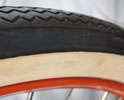Vintage and Antique Bicycle Tires
A Brief Look at Vintage and Antique Bicycle Tires
by Dave Stromberger
 Early Pneumatic Tire
Early Pneumatic Tire
The earliest bicycle tire was not filled with air. It was hard rubber strapped to the rim with a wire that was inserted through its center. This tire did not offer a cushy ride, but it was at least reliable as it could never get a flat. The idea for an air-filled or “pneumatic” tire was patented by Robert William Thompson in 1846. However, it wasn’t until 1887 when John Boyd Dunlop applied the idea to a bicycle wheel, constructing a pneumatic tire from a rubber garden hose for his son’s bicycle. Dunlop patented his idea, but it was later declared invalid due to Thompson’s earlier patent.
 Early Clincher Tire
Early Clincher Tire
 Single-Tube Tire
Single-Tube Tire
The early tire was made of canvas and rubber. It was glued to the rim, which had a mounting surface that was dished to hold the tire in place. This type of tire evolved over the years, but by the 1920s it was reliable and remained mostly unchanged until the mid-1930s, when the “single-tube” tire was standardized with a width of 1 1/2″. Narrower sizes, however, were available for racing bikes. In addition to the single-tube tire, the clincher tire (the technology of which is used today on most bicycles) was also available. The early clincher tire had a bead along the edge similar to a modern tire with the exception of an overlapping flap on the bottom to encase an inner-tube. By the early 1900s, the standard diameter of an adult-sized bicycle wheel was 28″, which gave it a tire size of 28 x 1 1/2″ (note: this size should not be confused with the modern European size by the same designation as the two sizes are not compatible).
 Balloon Tire
Balloon Tire
In 1932 Montgomery Ward advertised a larger-sized, single-tube tire equipped on bicycles they sold. Although this larger-sized tire was called a “balloon tire,” the more modern clincher-type tire introduced a year later by Arnold Schwinn & Co. in their bicycle line is the one that became commonly accepted today as the balloon tire. Schwinn’s new tire that measured 2 1/8″ across was marked 26 x 2.125, which departed from the former standard of marking tire sizes in fractions. While being of the clincher variety, Schwinn’s balloon-tire differed in its addition of a metal wire inside the beads and the elimination of extra rubber between them. This made tire installation easier. Furthermore, it was necessary to apply a separate rubber strap over the spoke nipples on the rim to protect the inner-tube. Such tire technology is still used today on modern cruisers as well as on BMX and mountain bikes.
 Middleweight Tire
Middleweight Tire
In 1955 Schwinn popularized the middleweight bicycle with the introduction of their new bicycle line that featured a tire with a width of 1 3/4″. The new smaller size was designed to hold more air pressure, which gave a slightly stiffer ride but with less rolling resistance to allow for easy peddling. For the first time, Schwinn adopted their own unique tire sizes, marking their tires with “Fits S-7 rims only.” Typically, a full-sized bicycle tire would have been labeled 26 x 1 3/4″ on a Schwinn but 26 x 1.75″ on the bike of another maker. It should be emphasized, though, that a Schwinn tire is not interchangeable with other bikes as its wheel has a larger diameter, something that causes confusion among new collectors to this day.
 26″ Lightweight Tire
26″ Lightweight Tire
Another popular tire size available during the balloon-tire and middleweight eras was a tire with a width of 1 3/8″. Called the “lightweight” tire, it was marked in decimals (1.375) or more commonly in fractions (1 3/8″). Schwinn used this standard size until the 1950s, at which time they promoted their own unique size just as they did with the middleweight tire. Schwinn’s lightweight size adopted the designation of S-5 or S-6, and their tires were labeled as fitting those rims exclusively.
 27″ Lightweight Tire
27″ Lightweight Tire
In the late 1960s and early 1970s the middleweight bicycle was supplanted by the 10-speed lightweight bicycle that rode on a larger 27″ wheel with a tire that was narrower yet at 1 1/4″. Just as the earlier middleweight tire, the new 27″ lightweight tire held a higher air pressure, once again increasing the stiffness of the ride while reducing rolling resistance. Unlike their previous tire sizes, Schwinn adopted the accepted standard this time rather than introduce their own size.
